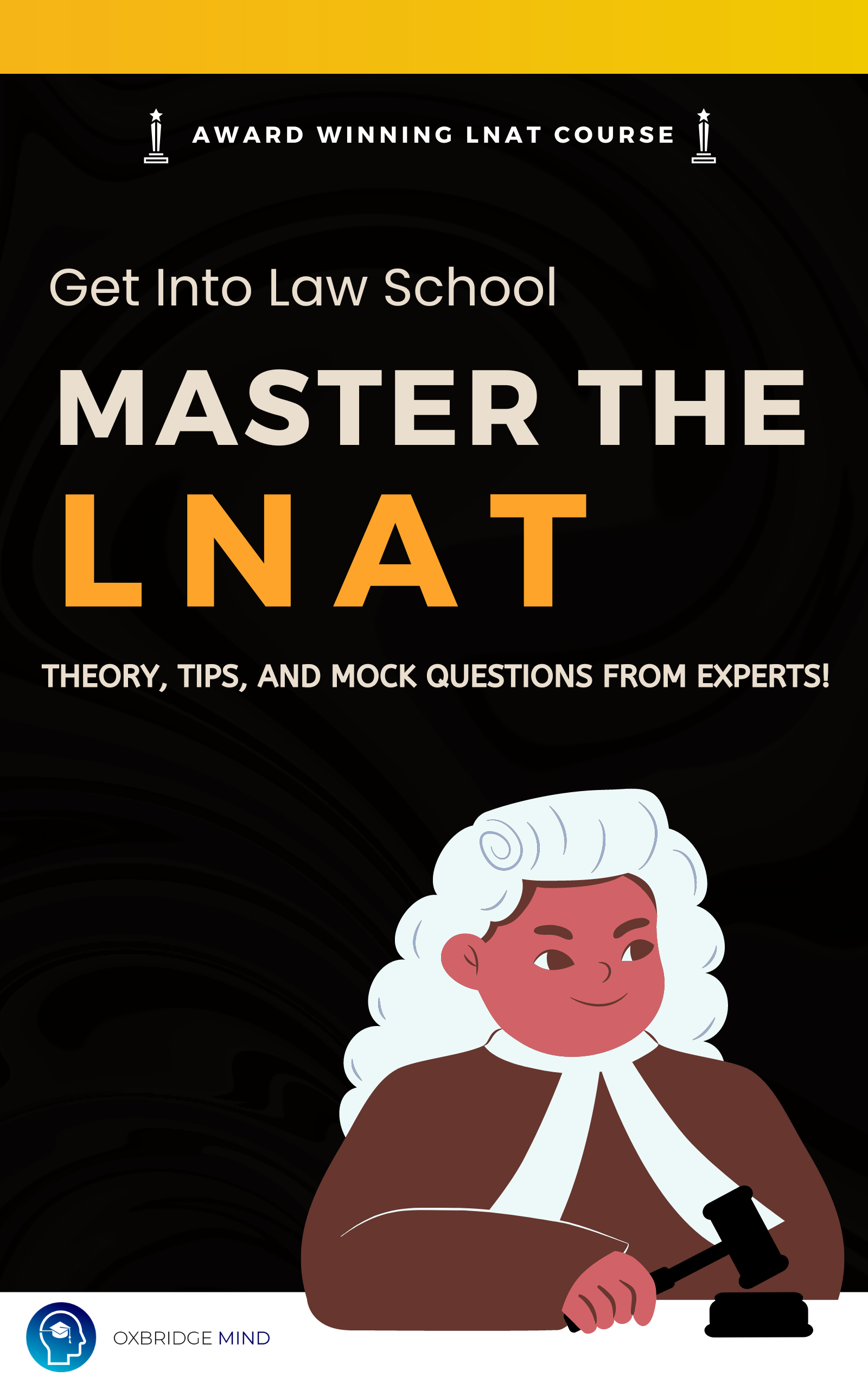As universities seek more than academic achievements, this guide navigates through the essence of LNAT, unveiling its structure, purpose, and the vital skills it evaluates. Join us on this journey, as we decode the pathways to success in the world of undergraduate law admissions.
What Is The LNAT?
Embarking on the journey toward undergraduate law studies requires a clear understanding of the Law National Aptitude Test (LNAT). As an aspiring law student, this section is designed to equip you with essential information to navigate this critical examination effectively.
The LNAT serves as a key tool for universities in selecting candidates for their undergraduate law courses. Unlike conventional assessments, the LNAT doesn’t test your knowledge of law; instead, it evaluates your aptitude for the skills essential to studying law.
Delving deeper, let’s explore how the LNAT fits into the broader landscape of university law admissions. By complementing other admission processes such as the UCAS application and academic qualifications, the LNAT aids universities in making fair and informed choices from a pool of highly-qualified applicants.
Understanding the overarching purpose of the LNAT is foundational to appreciating its significance in your law school journey. It goes beyond mere test preparation; it’s about showcasing your potential to thrive in the challenging yet rewarding environment of undergraduate law programmes.
What Is The Structure Of The LNAT?
To master the Law National Aptitude Test (LNAT), it’s crucial to comprehend its distinctive two-part structure.
Two-Part Examination:
The LNAT stands out for its unique design, encompassing two distinct sections that assess various facets of your capabilities. This understanding is fundamental to tailoring your preparation effectively.
Understanding the structure of the LNAT sets the foundation for effective preparation. In the subsequent sections, we’ll break down each component, offering actionable strategies and insights to ensure you navigate the LNAT with confidence and success.
LNAT Section A
In the Law National Aptitude Test (LNAT), Section A serves as the gateway to assessing your comprehension skills and analytical thinking. This section is a nuanced examination, delving into various facets that demand a keen understanding. Let’s explore the intricacies of LNAT Section A and equip you with actionable strategies to navigate it effectively, ensuring a comprehensive grasp of the test.
Reading Passages and Comprehension Questions:
Reading passages in Section A are pivotal components of the LNAT test. It involves a computer-based multiple-choice exam where you’ll read passages and answer questions, evaluating your comprehension skills. Identifying key themes within passages becomes crucial, allowing you to streamline your comprehension process effectively.
Practice navigating through dense information, focusing on main ideas, and strategically skipping over less crucial details. Time management is a key component here; allocate specific time for each passage and question, honing your speed and accuracy through timed practice sessions.
Scoring System and LNAT Score:
Understanding the LNAT scoring system is paramount for optimising your performance. Your scores from the multiple-choice section of the test are computer-checked, resulting in a mark out of 42 known as your LNAT score. Recognising the contribution of each question to your overall score is essential, prioritising accuracy over speed.
Avoid common pitfalls, such as falling for misleading answer choices, and develop a critical eye to spot nuances in questions. This comprehensive approach ensures you navigate Section A with a strategic mindset, maximising your chances of a favourable LNAT score.
What Does the LNAT Section A Test?
LNAT Section A goes beyond testing mere comprehension; it evaluates your ability to critically analyse information. Engage in analytical thinking exercises to sharpen your skills, summarising passages in your own words, identifying implicit assumptions, and developing a keen sense of discernment.
Mock tests serve as invaluable tools for simulating the LNAT environment, allowing you to identify patterns in your performance and develop targeted strategies for improvement. As we guide you through this comprehensive LNAT exploration, remember that thorough preparation is the key to unlocking your potential in the test. Next, our journey continues to LNAT Section B, delving into the art of essay writing and providing you with tools to excel in this unique aspect of the examination.
LNAT Section B
This section is a nuanced examination, delving into the intricacies of essay writing in the Law National Aptitude Test. Let’s explore LNAT Section B in detail and equip you with actionable strategies to excel in this unique aspect of the examination.
Topics and Selection:
In LNAT Section B, your writing journey begins with the selection of a suitable topic from a list of three proposed subjects. This choice is pivotal, offering you the opportunity to showcase your interests and strengths.
To make an informed selection, delve into the list thoughtfully. Choose a topic that resonates with you, aligns with your perspectives, and allows you to articulate a compelling argument. This approach ensures your essay reflects not only your analytical prowess but also your unique voice.
Non-scoring Nature and Its Role:
Unlike Section A, Section B does not directly contribute to your LNAT score. However, its role is far from negligible. This section is not marked by the test centre and does not impact your numeric score. Still, it plays a vital role in showcasing your analytical writing skills—a key aspect of your overall aptitude for law studies.
Universities use your essay to gauge your ability to construct a cohesive argument, analyse complex issues, and present a well-structured response. As you approach this section, understand that while it won’t impact your LNAT score, it provides a valuable opportunity to demonstrate your capabilities in constructing compelling arguments and reaching insightful conclusions.
What Does the LNAT Section B Test?
LNAT Section B places a premium on your ability to craft a persuasive argument and showcase analytical writing skills. To navigate this effectively, start by honing your essay-writing capabilities. Practice constructing clear thesis statements, organising your thoughts logically, and presenting well-supported arguments.
Delve into past essay topics, dissecting the nuances of each to understand the expectations. As you prepare, focus not just on the content but also on the structure and clarity of your expression. This comprehensive approach ensures you approach LNAT Section B with a solid foundation and strategic mindset.
The next section of this guide will provide you with actionable strategies for mastering the art of writing an LNAT essay, ensuring you excel in this unique aspect of the examination.
How to Write An LNAT Essay
As we delve into the final section of our LNAT guide, the focus turns to the art of crafting an impressive LNAT essay—an integral aspect of the examination where your ability to construct compelling arguments and conclusions takes centre stage. Let’s explore actionable strategies to guide you through the essay-writing process and ensure you present a persuasive and well-structured response.
Importance of Preparation
Preparing for the LNAT essay goes beyond content knowledge; it’s about refining your writing skills and strategic thinking. Familiarise yourself with various essay structures, understand how to develop a coherent argument, and practice expressing your thoughts concisely.
Prioritise clarity and precision in your writing, ensuring that your ideas are communicated effectively.
Recommended Strategies
1. Understand the Question:
Before diving into your essay, take the time to thoroughly understand the question. Identify key terms and nuances to ensure your response directly addresses the prompt.
2. Plan Your Response:
Outline your essay before starting to write. Organise your thoughts logically, ensuring a smooth flow from the introduction to the conclusion. A well-structured plan lays the foundation for a compelling essay.
3. Support Your Argument:
Back your arguments with evidence and examples. Whether drawing from real-life scenarios or legal precedents, solidify your position with well-supported points.
4. Balance Perspectives:
Acknowledge different perspectives on the issue at hand. A well-rounded essay considers counterarguments, showcasing your ability to analyse complex issues comprehensively.
5. Conclude Effectively:
Craft a conclusion that summarises your main points and reinforces your stance. Leave the reader with a lasting impression, emphasising the strength of your argument and the coherence of your essay.
The Bottom Line:
By incorporating these strategies into your preparation, you’ll be well-equipped to approach the LNAT essay with confidence. Remember that this section provides a unique opportunity to showcase your analytical writing skills, and a well-crafted essay can leave a lasting impression on university admissions teams.
As you embark on your essay-writing journey, keep in mind that the skills honed here extend beyond the LNAT and will serve you well in your future academic endeavours.
And if you’re looking for expert tutors. We can help you prepare for the test with our LNAT tutoring programme, increasing success by 40%.
Best of luck on your LNAT journey!
FAQs
How much time should I allocate for LNAT Section A to ensure optimal performance?
While individual pacing may vary, allocating approximately 1.8 to 2 minutes per question in LNAT Section A is a strategic approach. This allows sufficient time for thoughtful reading of passages and precise answering. Practice under timed conditions to refine your time management skills and strike the right balance between speed and accuracy.
Is it advisable to choose a complex topic for my LNAT essay to stand out?
While a unique perspective is valuable, clarity and depth of argumentation are paramount. It’s essential to choose a topic you understand well and can analyse effectively within the given time frame. Focus on presenting a well-supported argument rather than opting for complexity for its own sake.
Can I bring extra materials, such as notes or a dictionary, to the LNAT examination?
No, the LNAT is a closed-book examination, and you are not allowed to bring any additional materials into the test centre. This includes notes, dictionaries, or any other reference materials. Familiarise yourself with the test conditions during practice to ensure a smooth and stress-free experience on test day.
What is the role of critical thinking in LNAT Section A?
Critical thinking is central to LNAT Section A, where you are required to analyse and comprehend complex passages. It involves evaluating information objectively, identifying underlying assumptions, and drawing logical conclusions. Developing your critical thinking skills through regular practice and exposure to diverse materials will enhance your performance in this section.
Can I skip questions in LNAT Section A and come back to them later?
Yes, you can skip questions in LNAT Section A and return to them later. Managing your time effectively is crucial, and if a particular question proves challenging, move on to ensure you answer as many questions as possible. Remember to mark questions you skip for easy identification when reviewing your responses.
Are there penalties for incorrect answers in LNAT Section A?
No, there are no penalties for incorrect answers in LNAT Section A. Your score is based solely on the number of correct answers. Therefore, it is advisable to attempt all questions, even if you are uncertain about some. This strategy maximises your chances of earning points without the risk of deductions for incorrect responses.


